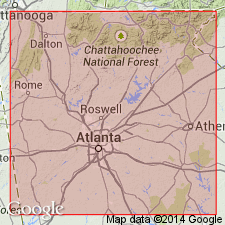
- Usage in publication:
-
- Sandy Springs Group*
- Modifications:
-
- Named
- Dominant lithology:
-
- Schist
- Quartzite
- Gneiss
- Amphibolite
- AAPG geologic province:
-
- Piedmont-Blue Ridge province
Summary:
The informal Sandy Springs sequence of Higgins (1966) is here named Sandy Springs Group, for a series of northeast-trending quartzite ridges and valleys underlain by schist, gneiss, and amphibolite. It contains the Powers Ferry Formation, Chattahoochee Palisades Quartzite, Factory Shoals Formation, and Rottenwood Creek Quartzite.
Source: GNU records (USGS DDS-6; Reston GNULEX).
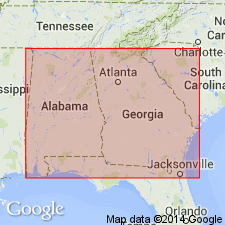
- Usage in publication:
-
- Sandy Springs Group*
- Modifications:
-
- Revised
- AAPG geologic province:
-
- Piedmont-Blue Ridge province
Summary:
The uppermost unit of the Sandy Springs Group, the Rottenwood Creek Quartzite, is here abandoned because remapping has shown that it is actually the Chattahoochee Palisades Quartzite.
Source: GNU records (USGS DDS-6; Reston GNULEX).
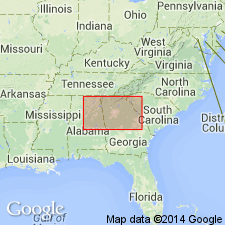
- Usage in publication:
-
- Sandy Springs Group*
- Modifications:
-
- Age modified
- AAPG geologic province:
-
- Piedmont-Blue Ridge province
Summary:
The Sandy Springs Group in the Sandy Springs thrust sheet, GA and AL, includes, in ascending order, the Powers Ferry Formation, Chattahoochee Palisades Quartzite, and Factory Shoals Formation. Age is Late Proterozoic to Early Ordovician(?).
Source: GNU records (USGS DDS-6; Reston GNULEX).
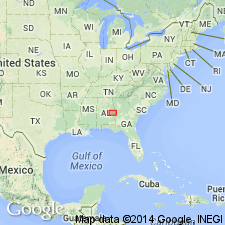
- Usage in publication:
-
- Sandy Springs Group
- Modifications:
-
- Revised
- AAPG geologic province:
-
- Piedmont-Blue Ridge province
Summary:
Lithologic units that compose the Jacksons Gap Group do not disappear beneath the Coastal Plain as previously thought, but can be mapped eastward around the hinge zone of the Tallassee synform where along the eastern limb they become the Loachapoka Schist of the Opelika Complex. The Loachapoka continues along the east limb of the synform into GA where it corresponds to the Sandy Springs thrust sheet of Higgins and others (1988). The Saugahatchee quartzite of the Loachapoka Schist, the Tallassee and Devils Backbone quartzites of the Jacksons Gap Group, and the Chattahoochee Palisades Quartzite are correlative. Authors suggest that the name Chattahoochee Palisades Quartzite be applied to these quartzites and further recommend that the schists of the Loachapoka and Jacksons Gap Group be referred to as the Factory Shoals Formation of the Sandy Springs Group.
Source: GNU records (USGS DDS-6; Reston GNULEX).
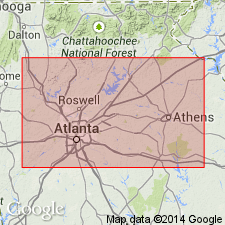
- Usage in publication:
-
- Sandy Springs Group*
- Modifications:
-
- Revised
- AAPG geologic province:
-
- Piedmont-Blue Ridge province
Summary:
Remapping of Sandy Springs Group in its type area during 1990-1993 indicates that, rather than being a stratigraphic sequence preserved in a fault zone as originally thought, Sandy Springs is actually a sequence of fault slices that mimics true stratigraphy. Detailed mapping also has shown that rocks mapped as Powers Ferry Formation of Sandy Springs Group are actually a facies of Stonewall Gneiss and are in fault contact with other units of Sandy Springs. Powers Ferry is removed from Sandy Springs Group and reassigned as Powers Ferry Member of Stonewall Gneiss. Detailed mapping also has shown that rocks mapped as Factory Shoals Formation of Sandy Springs Group cannot be mapped away from its type locality or section and are instead inseparable from the aluminous unit of Sandy Springs Group; therefore, the Factory Shoals Formation is abandoned herein and its rocks included in the informal aluminous schist unit. As revised here, Sandy Springs Group consists of 1) an aluminous schist unit containing one or more unnamed quartzites, 2) Chattahoochee Palisades Quartzite, and 3) an unnamed garnetiferous schist; it is not known if unnamed quartzites in aluminous schist are Chattahoochee Palisades Quartzite. Age is tentatively changed to Late Proterozoic to Middle Ordovician. it is younger than basement because Chattahoochee Palisades Quartzite contains zircons derived from basement. Report includes geologic map and correlation chart.
Source: GNU records (USGS DDS-6; Reston GNULEX).
For more information, please contact Nancy Stamm, Geologic Names Committee Secretary.
Asterisk (*) indicates published by U.S. Geological Survey authors.
"No current usage" (†) implies that a name has been abandoned or has fallen into disuse. Former usage and, if known, replacement name given in parentheses ( ).
Slash (/) indicates name conflicts with nomenclatural guidelines (CSN, 1933; ACSN, 1961, 1970; NACSN, 1983, 2005, 2021). May be explained within brackets ([ ]).

